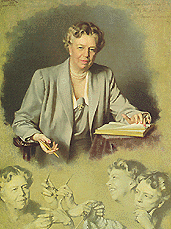|

Anna Eleanor Roosevelt Roosevelt
1884-1962
[Franklin D.
Roosevelt]
Biography: A shy, awkward child, starved for recognition and love,
Eleanor Roosevelt grew into a woman with great sensitivity to the underprivileged of all
creeds, races, and nations. Her constant work to improve their lot made
her one of the most loved--and for some years one of the most
reviled--women of her generation.
She was born in New York City on October 11, 1884, daughter of lovely
Anna Hall and Elliott Roosevelt, younger brother of Theodore. When her
mother died in 1892, the children went to live with Grandmother Hall; her
adored father died only two years later. Attending a distinguished
school in England gave her, at 15, her first chance to develop
self-confidence among other girls.
Tall, slender, graceful of figure but apprehensive at the thought of
being a wallflower, she returned for a debut that she dreaded. In her
circle of friends was a distant cousin, handsome young Franklin Delano
Roosevelt. They became engaged in 1903 and were married in 1905, with
her uncle the President giving the bride away. Within eleven years
Eleanor bore six children; one son died in infancy. "I suppose I was
fitting pretty well into the pattern of a fairly conventional, quiet,
young society matron," she wrote later in her autobiography.
In Albany, where Franklin served in the state Senate from 1910 to 1913,
Eleanor started her long career as political helpmate. She gained a
knowledge of Washington and its ways while he served as Assistant
Secretary of the Navy. When he was stricken with poliomyelitis in 1921,
she tended him devotedly. She became active in the women's division of
the State Democratic Committee to keep his interest in politics alive.
From his successful campaign for governor in 1928 to the day of his
death, she dedicated her life to his purposes. She became eyes and ears
for him, a trusted and tireless reporter.
When Mrs. Roosevelt came to the White House in 1933, she understood
social conditions better than any of her predecessors and she transformed
the role of First Lady accordingly. She never shirked official
entertaining; she greeted thousands with charming friendliness. She also
broke precedent to hold press conferences, travel to all parts of the
country, give lectures and radio broadcasts, and express her opinions
candidly in a daily syndicated newspaper column, "My Day."
This made her a tempting target for political enemies but her integrity,
her graciousness, and her sincerity of purpose endeared her personally to
many--from heads of state to servicemen she visited abroad during World
War II. As she had written wistfully at 14: "...no matter how plain a
woman may be if truth & loyalty are stamped upon her face all will be
attracted to her...."
After the President's death in 1945 she returned to a cottage at his Hyde
Park estate; she told reporters: "the story is over." Within a year,
however, she began her service as American spokesman in the United
Nations. She continued a vigorous career until her strength began to
wane in 1962. She died in New York City that November, and was buried
at Hyde Park beside her husband.
You can learn more about Mrs. Roosevelt from
The Franklin D. Roosevelt Presidential Library
maintained by Marist College.



|

